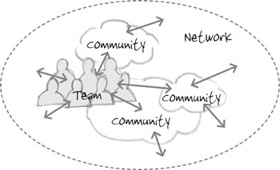Blog
Subscribe
Join over 5,000 people who receive the Anecdotally newsletter—and receive our free ebook Character Trumps Credentials.
Categories
- Anecdotes
- Business storytelling
- Collaboration
- Communication
- Corporate Storytelling
- Culture
- Decision-making
- Employee Engagement
- Events
- Fun
- Insight
- Leadership Posts
- News
- Podcast
- Selling
- Strategy
Archives
- April 2024
- March 2024
- December 2023
- November 2023
- October 2023
- September 2023
- August 2023
- July 2023
- June 2023
- May 2023
Years
Three types of collaboration

Nancy White and I have been working on a project to help our client enhance their collaboration practices. In the process we’ve identified three types of enterprise collaboration. Love to hear what you think of the idea. Nancy is riffing on this topic too and has added a bunch of other cool resources in her post.
Collaboration is the act of working with people to get something done. We can look at collaboration at three levels within the enterprise.
In Team Collaboration, the members of the group are known, there are clear task interdependencies, expected reciprocity, and explicit timelines and goals. To achieve the goal, members must fulfil their tasks within the stated time. Team Collaboration often suggests that while there is often explicit leadership, the participants cooperate on an equal footing and will receive equal recognition. An example is a research project to develop a prototype for X in five months with six team members and a set of resources.
In Community Collaboration, there is a shared domain or area of interest, but the goal is more often learning, rather than task. People share and build knowledge, rather than complete projects. Membership may be bounded and explicit, but periods are often open or ongoing. Membership is often on an equal footing, but more experienced practitioners may have more status or power in the community. Reciprocity is within the group, but not always one-to-one (‘I did this for you, now you do this for me“) An example might be a community of practice that is interested in the type of research mentioned in the team example above. A member of that team may come to her community and ask for examples of past projects.
Network Collaboration steps beyond the relationship centric nature of team and community collaboration. It is collaboration that starts in individual action and self interest and accrues to the network. Membership and timelines are open and unbounded. There are no explicit roles. Members most likely do not know all the other members. Power is distributed. This form of collaboration is driven by the advent of social software, a response to the overwhelming volume of information we are creating. It’s impossible for an individual to cope on their own.
An example of network collaboration might be members of the team in the first example above bookmarking web sites as they find them. This benefits their team, possibly their related communities of practice but it also benefits the wider network of people interested in the topic. At the same time, they may find other bookmarks left by network members relevant to their team work. This sort of network activity benefits the individual and a network of people reciprocally over time. The reciprocity connection is remote and undefined. You act in self-interest but provide a network-wide benefit.
Technorati Tags: nancy white, social software
About Shawn Callahan
Shawn, author of Putting Stories to Work, is one of the world's leading business storytelling consultants. He helps executive teams find and tell the story of their strategy. When he is not working on strategy communication, Shawn is helping leaders find and tell business stories to engage, to influence and to inspire. Shawn works with Global 1000 companies including Shell, IBM, SAP, Bayer, Microsoft & Danone. Connect with Shawn on:
Comments
Comments are closed.

Great: so teams and managers then don’t relate to communities as such – Individuals do, even if they are a member of a team or a manager.
Nice summary of these relationships, and good illustrations. – Derek